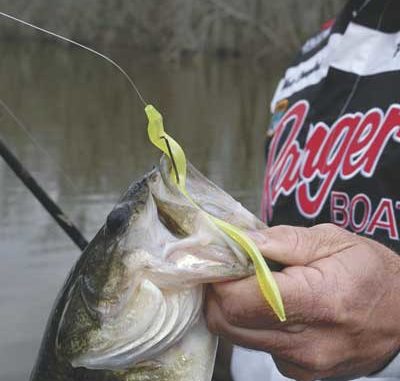
I like to call April the “plastic month.” It’s also the month when you really have to put the pedal to the metal.
What does that mean? Well, April actually is a tough month for me because I’m happier when fish are in deeper water, and during April, they’re as shallow as they’ll be all year.
I think everybody in North Carolina knows April is the big month for bass to spawn in our lakes. To consistently catch largemouth bass, anglers have to fish soft-plastic baits and put their feet on trolling motors and not let up. The best thing you can do is cover as much water as possible because you’re looking for fish that haven’t spawned yet.
At some of the lakes closer to South Carolina, such as Wylie, by the end of April most bass will have spawned. But at a lot of N.C.’s bigger lakes — Buggs Island, Gaston and Norman — at different areas of those lakes fish spawn earlier or later. At most of our lakes, fish will be on the beds or leaving them during April.
If they’re spawning or coming off, they’re tough to catch. You have to look for prespawn fish, and there might not be many of them left, especially later in the month.
Soft-plastic baits are really the ticket this time of year, but sometimes you can throw a little spinnerbait and do well if the water has some color. The only other exception is a Husky Jerk or an original Rapala.
Sometimes, you can throw them up in pockets near bushes where fish are bedding, twitch them a time or two and get fish to bite. But they’re really the only good hard-baits when bass get up on the banks.
My two best search baits in April are a Zoom Trick Worm and a Zoom Fluke. I fish them weedless with a worm hook.
Because I like to work them a little bit faster than other people — and because I like to fish a bait-casting rod and reel — I’ll add a little weight by sticking a little finishing nail in the head of the bait. That makes it castable, and it’s heavy enough that I’ve got to really keep it moving when I cast it up close to the bank. I work it by twitching and reeling in the slack, almost the way you’d walk a Zara Spook.
You’re using these soft-plastic baits the way you’d use a spinnerbait in March in dingier water; they’re search baits. You’re not really looking for spawning fish or post-spawn fish — although they’ll catch them — you’re looking for areas with aggressive fish.
Aggressive fish usually means prespawn fish because right before the spawn, a bass gets pretty easy to catch. And they’re up there shallow where they’re easy to catch.
There are a couple of things I keep in mind when I’m fishing a situation where most of the fish are either on the beds or coming off.
First, I look farther back in creeks. When the spawn starts, bass anglers will find most of the spawning fish in pockets closer to the main lake. As the spawn progresses, you find bass in coves and pockets a little closer to the middle of creeks. Toward the end of the spawn, the last bass that go shallow are at the back halves of creeks — so that’s also usually where your last prespawn fish are going to be.
Second, it’ll differ from lake to lake, but there will be certain kinds of areas and types of cover where bass will spawn, and where they’ll hold right before they go to the bank.
At lot of it has to do with the physical characteristics of the lake. There’s a lot of difference between Buggs Island and Wylie and High Rock.
At Buggs Island, fish spawn behind the bushes — if the water level is where it normally is — and they’ll hold at bushes before they spawn. At High Rock, they spawn at docks with brush, but they’ll get on rocks before they go shallow. At Wylie, bass spawn at pockets with slick bottoms.
Those are three different situations, and they bear out that you need to know what kind of cover fish will prefer at a lake you’re fishing.
When you’re covering water, looking for prespawn fish, you should target a number of different kinds of visible cover.
One neat thing about prespawn fish — besides being easy to catch — is they’re easy to pattern. If you can catch two or three fish and determine that they’re staging at a certain kind of bank or at a certain kind of cover, you can usually go right to other places like that and catch ’em.
One of my best springtime catches at Buggs Island was when we figured out fish had gone into big pockets but were holding at little side pockets — little indentations or dents in the bank. That wound up being a really good pattern we ran all day.
A lot of times, shallow stumps will be a good pattern, but sometimes it’ll be rocks.
Bass use cover like that when they go in and come back out of little pockets.
So be aware of what you’re fishing and what’s underneath it. That’s a key for me during April.
David Fritts is a 51-year-old professional fisherman from Lexington. He won the 1993 Bassmasters Classic, was the 1994 BASS Angler of the Year, and won the 1997 FLW Tour Championship. He is sponsored by Ranger Boats, Evinrude Outboards, Rapala, Zoom, VMC hooks, American RodSmiths, Bass Pro Shops and Chevy Trucks.




Be the first to comment